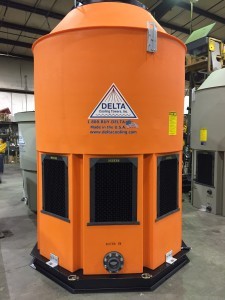
Work produces heat and excess heat is one of the biggest banes of industrial processes. In order to reduce heat in these facilities, protect equipment, elevate the level of safety, and improve productivity, facility managers resort to all sorts of cooling methods. One of these methods is evaporative cooling. Still, heat is not just a problem for industrial buildings but commercial buildings, as well.
Simply put, this is a process of losing temperature in water inside an open cooling system through evaporation. The heat on the surface of the water evaporates, thus liberating the less hot layers below. The process itself is often colloquially described to be similar to sweating, which is the basic human cooling process. It wasn’t long until the in-depth understanding of this process was put to use in industry and here’s what you need to know on this subject matter.
Evaporative cooling can be a very effective solution, especially for dry climates. These systems can be economical due to their mechnism for cooling by edding moisture to the environment.
The mechanism of an evaporative system is quite simple to explain. It’s supposed to work on a principle of water evaporation through which the air is cooled down to a comfortable temperature. From the very start, it’s more than clear that this evaporative cooling process is vastly different from the way in which AC works, even though their purpose is similar. Let’s take a closer look at these differences.
The Difference Between Evaporative Cooling Process and Central AC
When discussing evaporative coolers, the system that they’re most commonly compared to is the traditional central air conditioning system. The first, obvious, difference lies in the fact that evaporative doesn’t just rely on circulating the same air over and over again. Evaporative cooling provides a continuous stream of fresh air, which is already, clearly, a healthier option.
This makes evaporative cooling more efficient, eco-friendlier, and even more practical to enforce via a roof-mounted unit. With the help of a system fan, the air is dispersed in the form of a vapor (usually through vents).
In order to develop a better understanding of cooling towers and how they can be used in commercial buildings and industrial process plants.
commercial buildings and industrial process plants, it’s important that we start with the process itself. First of all, in a cooling tower, a combination of heat and mass transfer are taking place. There are two types of heat transfer:
Both of these transfer types happen simultaneously as warmer water collides with cooler air.
To put this into numbers, for every pound of evaporated water, about 1,000 Btu of heat are removed from the remaining water.
Moreover, the cooling of the water is proportional to the difference between the air leaving and entering the system. To put it even more simply, the heat given up by the water (falling into the tower) is equal to the heat gain of the air rising through the top of the tower.
In order to be completely honest, there are many different cooling systems out there, and, therefore, numerous different models of evaporative cooling towers. However, seeing as how they all function on a similar principle, all of them rest on a similar principle.
How old are evaporative cooling systems? Well, some of the first examples date all the way back to ancient Egypt. Recently, murals were discovered where long porous clay vessels were filled with water and placed beneath an air inlet. This way, when the air passed through them, they would provide cooling. Although it may sound strange, modern cooling towers (in an oversimplified manner of speaking) function on the same principle – the principle of evaporative cooling.
While they are mechanically superior and made out of more resilient materials, the architecture remains the same for one simple reason – it’s founded on a basic law of physics.
Speaking of these superior materials, a modern evaporative cooling tower is best when made out of engineered plastic. This increases its life expectancy, gives it a flexible modular design, and makes the installation a lot easier. This last part is especially important when talking about evaporative cooling in buildings. Delta cooling towers are made with HDPE plastic to eliminate failure due to corrosion and accommodate different cooling projects with various sizes and tonnage.
The advanced HDPE cooling models most commonly come in single and modular configurations. These have wide use in cooling massive building complexes like commercial, industrial, and institutional facilities but can also be used for other types of structures.
According to the case study of Davis Memorial who toured Delta Cooling Towers manufacturing facility in West Virginia, the choice of these towers may also be determined by various regional requirements. For instance, in areas that are close to the ocean (like in Florida), the potential for salt-air corrosion is especially high. This is what makes these open cooling towers made of engineered plastic so resilient and easy to maintain.
One more thing worth mentioning about these evaporative cooling systems is that these HDPE models come available in configurations that range from 10 to 2,400 cooling tons. Needless to say, such a wide range makes them potentially suitable for a large number of different applications.
Understanding how evaporative cooling works is not necessary in order to successfully use evaporative cooling through an open cooling tower. However, it helps you understand why it might be a better choice for your specific scenario, as well as understand why so many individuals and organizations choose to take this path. Still, with so many different systems to choose from, it’s more than clear that there are no one-size-fits-all solutions.
In order to get a more accurate estimate on the cooling tower needed for your own facility, get in touch with our team and get a quote today.
From our low maintenance design to our manufacturing process to excellent customer service, we're sure you'll be pleased with our superior cooling towers, every step of the way. Get a quote